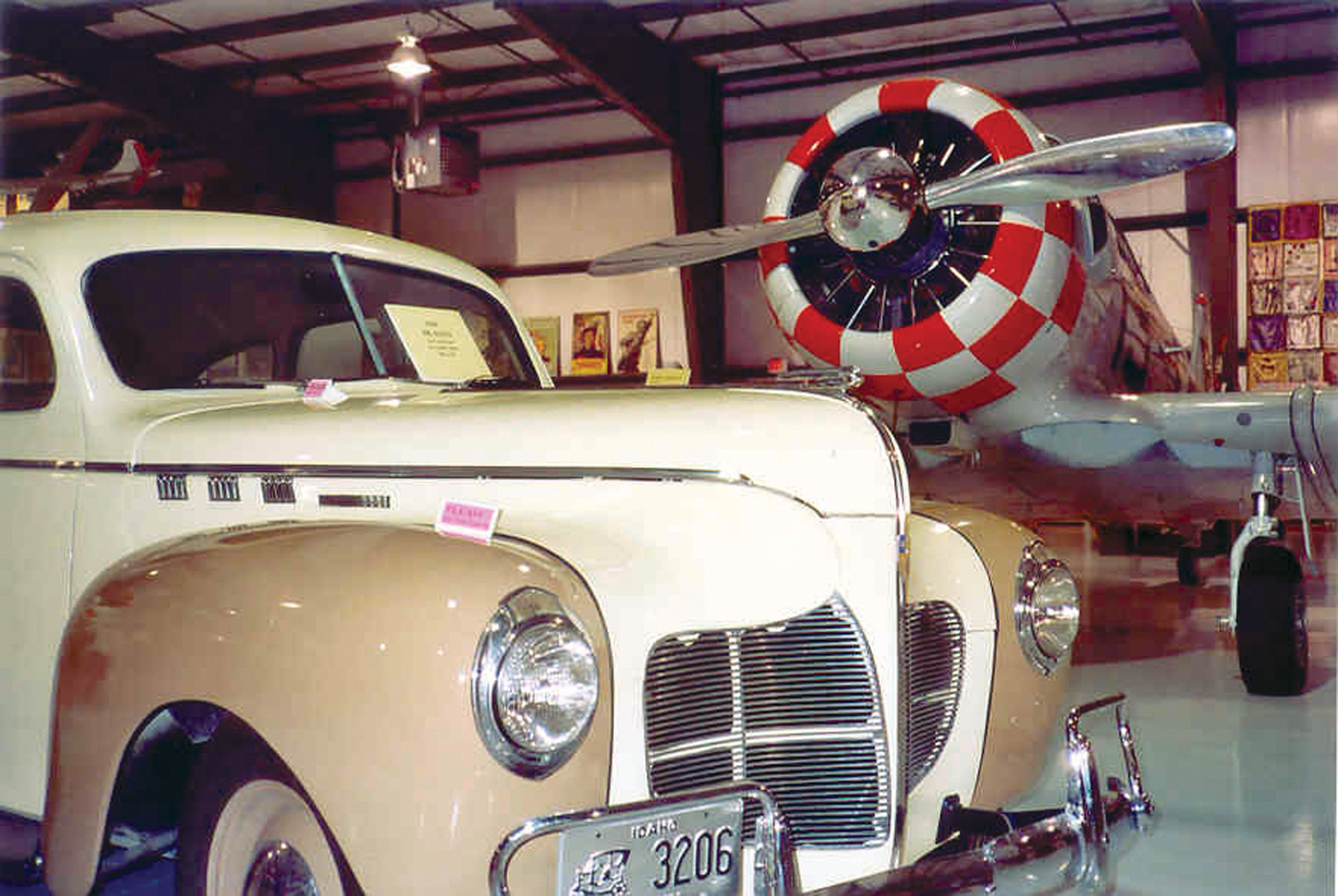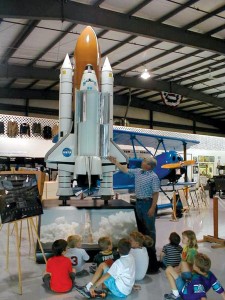By Vicki Graf
With summer’s blue skies beckoning, a P-51 Mustang roars over Nampa, Idaho, while a B-25 Mitchell bomber waits in the wings for its chance to impress spectators below. Hosted by the Warhawk Air Museum, these magnificent aircraft will be the focus of its third annual Warbird Invitationals, which, according to Executive Director Sue Paul, “offer the general public the chance to see, hear and experience the historic planes that are unique to each event.”
The P-51 Mustang Invitational, held June 11-12, will feature P-51s plus Curtiss P-40s and AT-6 trainers. In honor of the official end of WWII, the museum will host the B-25 Mitchell Bomber Invitational on August 13-14. In addition to viewing the B-25 in flight, visitors may tour the warbird between flights. Guest speaker will be Jonna Hoppes, Jimmy Doolittle’s granddaughter. Both events will include hands-on family activities, military exhibits and demonstration flights.
Special sponsor memberships for the events are available. In addition to a one-year special membership, sponsors will have a rare opportunity to fly in the sponsored aircraft. Special sponsor memberships range from $300 for the B-25 Mitchell Bomber, AT-6 or N3N to $350 for the T-28 Trojan and A-1 Skyraider, and $600 for the P-51 Mustang and Curtiss P-40. Admission to each invitational is $8 for adults and $6 for seniors and children ages 4-9. Proceeds support the museum’s education program and exhibits.
Located at Nampa Airport, 15 miles west of Boise, the Warhawk Air Museum combines 20th century war era artifacts and aircraft with space age technology in a WWII era setting.
“We value and honor the ordinary American heroes who sacrificed so much to give us the world we have today,” Paul said. “The museum is dedicated to preserving their histories and the technologies they created. It represents the home front, all fighting fronts, and all ages of American citizens.”
Personal collections of fighting front memorabilia gather in display cabinets: veterans’ medals, survival gear, letters from home, and trench art created by soldiers from bullets, casings and helmets. Impressive collections of mother’s flags, sweetheart pins and pillows, V-mail, and Victory-theme children’s books, puzzles and trading cards show home-front support. Also on display are German, Russian and Japanese uniforms, including a Japanese flying suit lined with rabbit fur. Wool lining and cowhides were the materials used for American flying suits. Women’s uniforms stand under a wall-size 48-star American flag in support of the war effort.
The museum’s WWII era theme has expanded to include Korean, Vietnam and WWI era collections.

Sue Paul, executive director of the Warhawk Air Museum, with the Curtiss P-40 that was featured in the movie “Pearl Harbor” with a 48-star U.S. flag in the background.
“We are excited that four collections of WWI memorabilia were donated to the museum in 2004/2005,” Paul said. “They’re beautiful collections, and we’re looking forward to more collections coming into the museum as people discover we have a place for their WWI memorabilia.”
A separate building for the Korean and Vietnam era collections will eventually accompany the current 17,000 square feet of exhibit area.
It all began with museum co-founder John Paul’s passion for airplanes. In the late 1950s, he was hooked by the sight and sound of two Corsair fighter planes flying over his third grade classroom. By age 20, he owned his first plane, an open-cockpit Fairchild PT-19 WWII trainer. In 1964, Paul married Sue Painter. The couple shortly thereafter bought a P-40E, which they restored at their California home.
Several years and a few vintage restorations later, the Pauls discovered P-40N parts buried in the field of a Canadian farm. A wing here, a stabilizer there—all but the fuselage. The farmer guessed that scrappers had taken it after his father purchased the plane for its nuts, bolts and other usable parts. After two days of digging up and loading the parts onto a truck, the Pauls returned to California, where the restoration began. The late 1980s brought a monumental move in which the Pauls and their vintage aircraft relocated to Idaho.
In 2001, both P-40s flew from Idaho to San Diego. They were shrink-wrapped, then barged to Hawaii for use in the movie “Pearl Harbor.” Now on display at the Warhawk Air Museum, the P-40s share the spotlight with a P-51C Mustang, an AT-6 trainer, a Navy N3N biplane trainer and a WWI Fokker triplane replica. Visiting aircraft in 2005 will be a T-28 Trojan, a WWII FM2 Wildcat, a WWII TBM, a Skyraider, and the aforementioned P-51 Mustang and B-25 Mitchell Bomber.
Also on board is a 1930 Packard Sedan, a 1942 Desoto, a 1918 Model T truck (winter only), and an engine display that includes an OX-5 engine. Developed by Glenn Curtiss, the OX-5 was the first mass-produced aircraft engine in the United States. It served in trainers through WWI and launched a post-war boom in general aviation.
Dedicated to teaching American history and culture to all generations, especially as it relates to aviation history, Kellie Dean, museum education director, has developed an age-appropriate, hands-on curriculum for Education Center and NASA Space Place Club guests.
“The education program we have created, which is extremely popular with schools throughout Idaho, is unique to any museum program in the United States,” said Paul. “To my knowledge, we are the only museum/education program that teaches the American experience of WWII.”
The education programs provide lessons about life in 1940s America, the importance of words like freedom, patriotism, honor and sacrifice, and the cultural changes and technologies that altered American life forever. While preschoolers learn basic concepts in the Transportation and Living in Space programs, high school students gain an understanding of the WWII experience through the popular Bridging the Generations program in which veterans gather to share their personal histories.
In 2003, Micron Technology Foundation granted funds to purchase an Academy of Engineering Lego Lab. Students ages 7 to 15 design, build and test their Lego models at monthly Lego workshops.
“The workshops focus on robotics, gear trains, simple machines and architectural design,” Dean said. “The Lego Lab propels students toward academic success, a higher level of critical thinking and problem-solving skills, and boosts self-esteem while increasing their knowledge of math, science and engineering.”
NASA’s Jet Propulsion Laboratories division sponsors the museum’s Space Place Club, a science-based program designed to motivate future space explorers. With the museum’s upcoming procurement of a traveling International Space Station Trailer, guests of all ages will have the opportunity to experience everyday life and work in an orbiting space station.
“The trailer will be stationed at the museum, but will move throughout the community to promote aerospace education at schools, special events and conferences,” Dean said.
Guests may also view NASA Johnson Space Center’s traveling exhibits on the museum floor, which have included a rotating space shuttle, an Apollo mission astronaut suit and moon rocks. This summer, guests will test their flight skills in an exhibit from NASA’s Langley Research Center. In the past, NASA traveling trailers have included the International Space Station Trailers; Starship 2040, NASA’s futuristic commercial space liner; and Benefits of Space, which highlights technology benefits derived from NASA’s space program.
The Warhawk Air Museum is one of the most active Veterans History Project centers in the United States. Since the first interview in 2003, museum volunteers have preserved the memories of over 160 veterans and civilian support people with a waiting list of 100 more.
“We’re losing over 1,800 WWII veterans a day,” said Tim Peterson, interviewer/film editor. “We’re trying our best to interview as many as we can. For a lot of folks, this interview is the first time they have chatted about their experience, and it gets very emotional at times.”
Fifteen volunteers, many of them veterans, conduct interviews, operate cameras, set up appointments with interviewees, keep records and edit filmed interviews. “It is an all day event to complete two interviews, and then we spend about 15 hours editing and burning to DVDs for archives at the Library of Congress,” Peterson said. “It’s such a small price to pay in order to record the recollections of veterans.”
Visitors are encouraged to watch taped interviews, explore the research library, and browse the gift shop in which Rosie the Riveter proclaims, “We Can Do It!” from the fronts of mugs, T-shirts and lunch boxes. It’s with that same can-do attitude that the Pauls continue to realize their dreams, always placing American people at the heart of their mission.
“It’s important that every visitor to the Warhawk Air Museum be treated with respect and made to feel welcome, and that all our dedicated volunteers and teaching staff feel that they’re the glue that holds our organization together,” said Paul. “Equally important is that the families who donate their cherished memorabilia leave here knowing that their loved one’s memory will be treated with respect and honor.”
For more information, call 208-465-6446 or visit [http://www.warhawkairmuseum.org].














